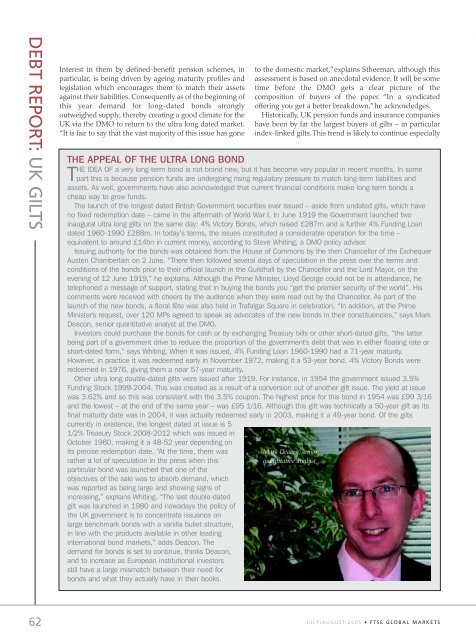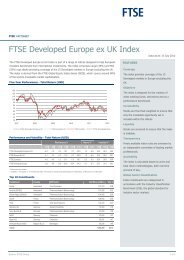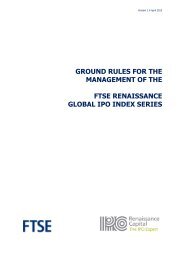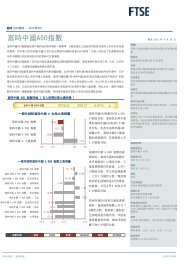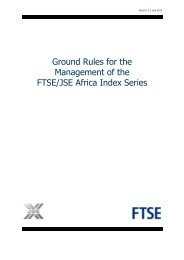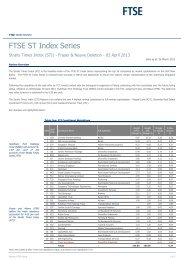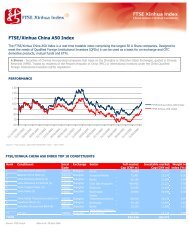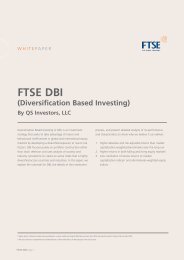Create successful ePaper yourself
Turn your PDF publications into a flip-book with our unique Google optimized e-Paper software.
DEBT REPORT: UK GILTS<br />
62<br />
Interest in them by defined-benefit pension schemes, in<br />
particular, is being driven by ageing maturity profiles and<br />
legislation which encourages them to match their assets<br />
against their liabilities. Consequently as of the beginning of<br />
this year demand for long-dated bonds strongly<br />
outweighed supply, thereby creating a good climate for the<br />
UK via the DMO to return to the ultra long dated market.<br />
“It is fair to say that the vast majority of this issue has gone<br />
THE APPEAL OF THE ULTRA LONG BOND<br />
to the domestic market,”explains Stheeman, although this<br />
assessment is based on anecdotal evidence. It will be some<br />
time before the DMO gets a clear picture of the<br />
composition of buyers of the paper. “In a syndicated<br />
offering you get a better breakdown,”he acknowledges.<br />
Historically, UK pension funds and insurance companies<br />
have been by far the largest buyers of gilts – in particular<br />
index-linked gilts. This trend is likely to continue especially<br />
THE IDEA OF a very long-term bond is not brand new, but it has become very popular in recent months. In some<br />
part this is because pension funds are undergoing rising regulatory pressure to match long-term liabilities and<br />
assets. As well, governments have also acknowledged that current financial conditions make long-term bonds a<br />
cheap way to grow funds.<br />
The launch of the longest dated British Government securities ever issued – aside from undated gilts, which have<br />
no fixed redemption date – came in the aftermath of World War I. In June 1919 the Government launched two<br />
inaugural ultra long gilts on the same day: 4% Victory Bonds, which raised £287m and a further 4% Funding Loan<br />
dated 1960-1990 £288m. In today’s terms, the issues constituted a considerable operation for the time –<br />
equivalent to around £14bn in current money, according to Steve Whiting, a DMO policy advisor.<br />
Issuing authority for the bonds was obtained from the House of Commons by the then Chancellor of the Exchequer<br />
Austen Chamberlain on 2 June. “There then followed several days of speculation in the press over the terms and<br />
conditions of the bonds prior to their official launch in the Guildhall by the Chancellor and the Lord Mayor, on the<br />
evening of 12 June 1919,” he explains. Although the Prime Minister, Lloyd George could not be in attendance, he<br />
telephoned a message of support, stating that in buying the bonds you “get the premier security of the world”. His<br />
comments were received with cheers by the audience when they were read out by the Chancellor. As part of the<br />
launch of the new bonds, a floral fête was also held in Trafalgar Square in celebration. “In addition, at the Prime<br />
Minister's request, over 120 MPs agreed to speak as advocates of the new bonds in their constituencies,” says Mark<br />
Deacon, senior quantitative analyst at the DMO.<br />
Investors could purchase the bonds for cash or by exchanging Treasury bills or other short-dated gilts, “the latter<br />
being part of a government drive to reduce the proportion of the government's debt that was in either floating rate or<br />
short-dated form,” says Whiting. When it was issued, 4% Funding Loan 1960-1990 had a 71-year maturity.<br />
However, in practice it was redeemed early in November 1972, making it a 53-year bond. 4% Victory Bonds were<br />
redeemed in 1976, giving them a near 57-year maturity.<br />
Other ultra long double-dated gilts were issued after 1919. For instance, in 1954 the government issued 3.5%<br />
Funding Stock 1999-2004. This was created as a result of a conversion out of another gilt issue. The yield at issue<br />
was 3.62% and so this was consistent with the 3.5% coupon. The highest price for this bond in 1954 was £99 3/16<br />
and the lowest – at the end of the same year – was £95 1/16. Although this gilt was technically a 50-year gilt as its<br />
final maturity date was in 2004, it was actually redeemed early in 2003, making it a 49-year bond. Of the gilts<br />
currently in existence, the longest dated at issue is 5<br />
1/2% Treasury Stock 2008-2012 which was issued in<br />
October 1960, making it a 48-52 year depending on<br />
its precise redemption date. “At the time, there was<br />
Mark Deacon, senior<br />
rather a lot of speculation in the press when this<br />
quantitative analyst<br />
particular bond was launched that one of the<br />
objectives of the sale was to absorb demand, which<br />
was reported as being large and showing signs of<br />
increasing,” explains Whiting. “The last double-dated<br />
gilt was launched in 1980 and nowadays the policy of<br />
the UK government is to concentrate issuance on<br />
large benchmark bonds with a vanilla bullet structure,<br />
in line with the products available in other leading<br />
international bond markets,” adds Deacon. The<br />
demand for bonds is set to continue, thinks Deacon,<br />
and to increase as European institutional investors<br />
still have a large mismatch between their need for<br />
bonds and what they actually have in their books.<br />
JULY/AUGUST 2005 • <strong>FTSE</strong> GLOBAL MARKETS


